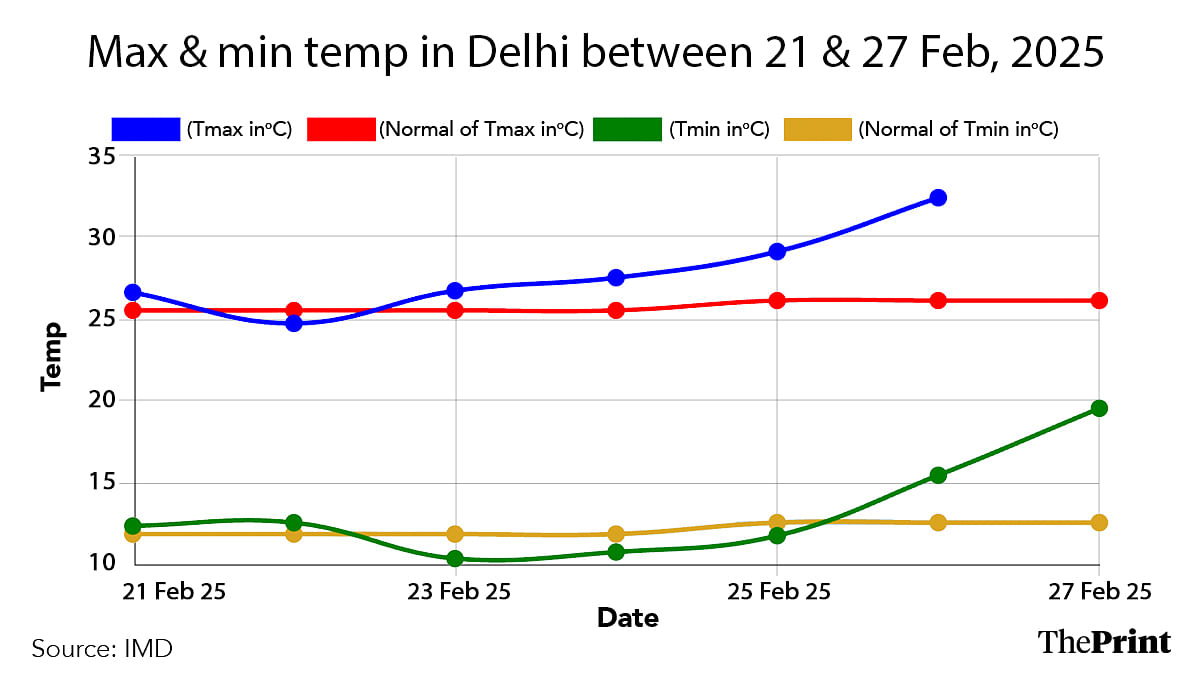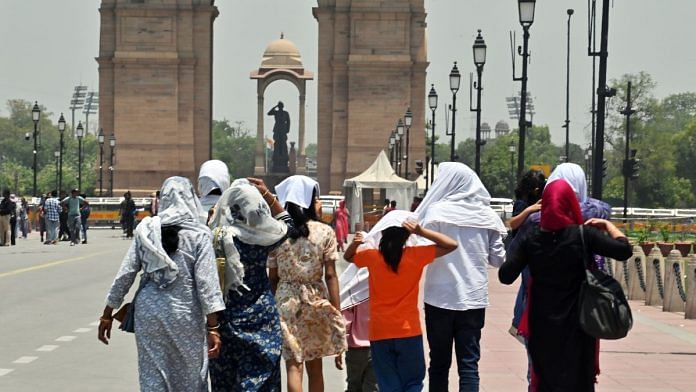New Delhi: At 32.4 degrees Celsius, the national capital Wednesday recorded the hottest day of the year and the highest February temperature since 2023, according to the India Meteorological Department (IMD). Moreover, Thursday morning, Delhi recorded the highest-ever minimum temperature in February since 1951 at 19.5 degrees Celsius, marking another heat milestone so early in the year.
At the same time, Mumbai and some other places on the Konkan coast have received heatwave warnings.
On Tuesday, Mumbai saw temperatures reach 38.7 degrees Celsius—which is 5.9 degrees Celsius above normal. Parts of coastal Maharashtra, Karnataka, and Goa also recorded similar temperatures, bringing in the heatwave season just two months into the New Year.
In the IMD’s press release Thursday, it reported that Kannur in Kerala recorded the highest maximum temperature in the country at 40.4 degrees Celsius Monday, which was 4.4 degrees Celsius above normal.
Experts say that India’s winter season is shrinking, with rising temperatures pushing heatwaves earlier into the year. The trend of increasingly short winters and prolonged hot periods is becoming more evident worldwide, with climate change being a key factor. This is because climate change-induced global warming contributes to a greater number of stronger heat waves.
However, the reason for these early heatwaves in coastal Maharashtra and Konkan is also a lack of rainfall in the winter season, meteorological experts say.
“While the waxing and waning of rainfall during any particular season can be considered normal, we cannot rule out the role of climate change in the gradual rise in average temperatures over the years,” Mahesh Palawat, Vice-President of meteorology and climate change at Skymet Weather, said in a press statement. “It has been established that global warming has affected the winter rainfall in India.”
Also Read: Climate activists diss profit-driven COP29, say socialist action can bring change
Fluctuating weather
Despite an above-average hot day Wednesday, Delhi residents woke up to a largely cloudy and windy day with traces of rainfall Thursday. The average temperature for February in Delhi is between 24 and 26 degrees Celsius, but the national capital has seen fluctuations this week due to the western disturbance over northwest India, which is causing rain and snowfall over Jammu and Kashmir. While Wednesday recorded a very high maximum temperature at 32.4 degrees Celsius, Thursday was much lower at 25 degrees Celsius.

In Maharashtra and Konkan, the fluctuations have been in terms of rainfall. Palawat explained that there were no significant weather systems this year during winter, making it “one of the driest winter seasons”.
Data shared by think tank Climate Trends showed that Maharashtra, which usually receives around seven millimetres of rainfall in January and February, saw a 99 percent deficit. Similarly, Kerala and Karnataka saw 64 percent and 80 percent deficits in their winter rainfall, respectively.
“An anti-cyclone has been persisting over Madhya Pradesh, pushing warm easterly winds across the West Coast. These inland winds delayed the setting in of the sea breeze, and the prolonged land breeze led to a rise in mercury,” explained Palawat. “Besides this, high humidity levels due to the proximity of the coast increased discomfort manifold, resulting in heatwave-like conditions.”
For Akshay Deoras, a research scientist at the National Centre for Atmospheric Science and the department of meteorology, University of Reading, the answer lies in climate change.
“Anthropogenic climate change is escalating both meteorological and hydrological extremes worldwide, resulting in frequent record-breaking weather events,” he said in a statement. “Currently, warmer-than-usual temperatures are being observed across all continents, indicating a relatively uniform global warming pattern.”
According to the IMD, western India and the Konkan coast will continue to witness heatwave-like conditions in the coming days, with some pockets also experiencing hot and humid conditions—temperatures will remain at least three percent above normal.
Northwest India, on the other hand, might see a dip of two to three degrees Celsius over the next two days, but people will need to brace themselves for a rise of four to six degrees Celsius soon after.
(Edited by Radifah Kabir)
Also Read: Water-energy security is crucial for India’s climate goals. Three key strategies will help






